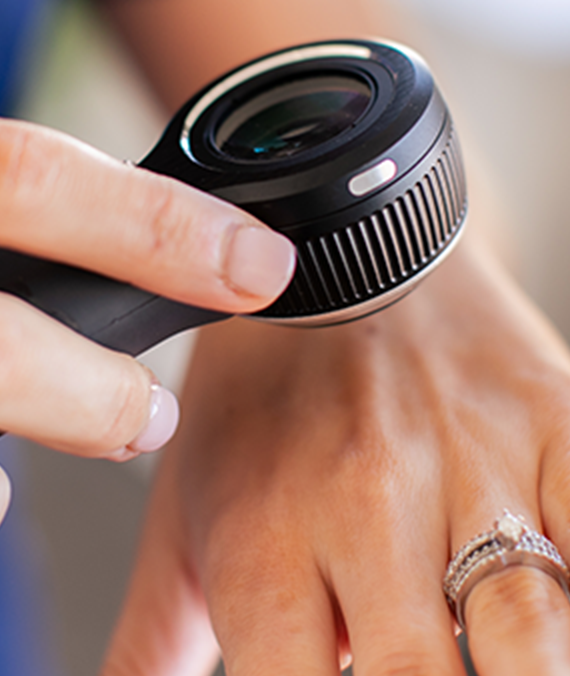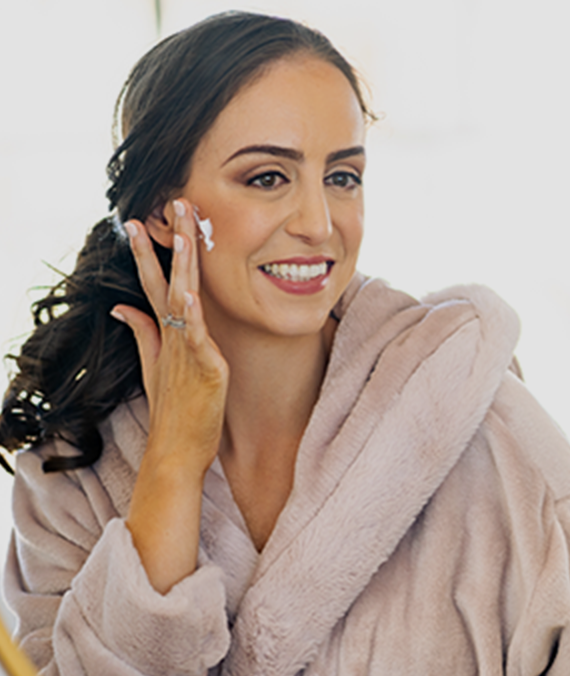Are you struggling with dry, scaly, or flaky hands?
Do you have red, irritated skin on your hands?
Do they burn?
Are your hands full of blisters or painful cracks?
If you answered “yes” to any of these questions, you may be struggling with hand dermatitis, also known as hand eczema. It’s a severe form of dry skin that’s extremely common – it affects about 10% of the general population.
With the COVID-19 pandemic and flu season upon us, you’re constantly washing your hands. While you’re out grocery shopping and running errands, you’re frequently using hand sanitizer.
We’re in the middle of National Handwashing Awareness Week (December 6-12, 2020). It’s the perfect time to remind ourselves that handwashing saves lives. You want to keep you and your family safe from viruses and bacteria, but you’re clearly struggling with dry, painful skin.
- What causes dry skin in the first place?
- What causes hand dermatitis?
- What can you do so handwashing doesn’t irritate your skin?
- What can you do to treat hand dermatitis?
We’ll explore the answers to these questions in this blog post!
What causes dry skin?
Dry skin occurs due to changes in the environment. For example, many people struggle with dry skin from the cold weather in wintertime. Other causes of dry skin can be:
- hot showers
- drying soaps and surfactants
- handwashing
- alcohol-based hand sanitizers
- certain medications
- low humidity environments
- chemicals like industrial and cleaning solvents.
What do these things have in common?
Each of these things dries out your skin by increasing the amount of water that your skin loses. To counteract that water loss, most of us reach for some skin moisturizer.
How does moisturizer work?
Moisturizers reduce your skin’s transepidermal water loss (TWL). The skin’s outermost layer is the epidermis, and the middle layer is the dermis. TWL is the amount of water that passes from the dermis and evaporates to the epidermis.We want low values of water loss because our skin cells need water to perform their daily functions. Water helps to keep our skin hydrated, younger-looking, and less prone to wrinkles.
In addition to reducing TWL, moisturizers help to restore skin softness and help to soothe dermal nerve endings that become exposed by creating a barrier.
Moisturizers and at home moisturizing treatments can normally treat dry skin. What if moisturizers aren’t completely curing your dry skin though? You may be suffering from more than just dry skin–you may have hand dermatitis.
What causes hand dermatitis? There are 3 main factors.
Hand dermatitis (or hand eczema) is severe dry skin characterized by inflammation. It may be caused by: genetic factors, allergens, and/or irritants. Let’s explore these 3 risk factors.
1. Genetic factors
When it comes to hand dermatitis, some genes in your body could be causing damage to your skin barrier. The condition begins normally in childhood but can affect anyone of any age.
For example– take filaggrin, a skin barrier protein. Filaggrin gives our skin barrier mechanical strength. It also helps to produce natural moisturizing factors. Someone with a genetic mutation in their filaggrin gene has an increased risk for hand dermatitis. Their skin can’t retain water or shield itself from contaminants well.
2. Allergens
Sometimes our skin can come in contact with an allergen leading to an allergic reaction. Contact allergens are responsible for one-half of all hand dermatitis cases. For example, some people have nickel and perfume allergies. The area of their hand that touched the allergen becomes inflamed.
Allergens lead to your immune system releasing antibodies called Immunoglobulin E (IgE). These IgE antibodies travel to cells that release histamines. The histamines are chemicals that cause an allergic reaction like inflammation.
3. Irritants
While allergens and irritants can both be chemicals, irritants don’t cause an immune response. Instead, irritants cause inflammation to your skin that leads to damage at your skin’s surface.
Hand dermatitis is the most common occupational skin disease. Some of these occupations that are more prone to hand dermatitis than others include:
- nurses, doctors, and hospital workers
- manual workers in chemical companies
- hairdressers
- cement and construction workers
- house cleaners
- food preparation workers.
Workers in these industries are exposed to chemical irritants such as cleansers and detergents, solvents, disinfectants, and even water on a regular basis. Take nurses as an example. They are at an increased risk of hand dermatitis because they:
- frequently wash their hands
- use disinfectants and detergents
- are exposed to medical substances
- wear rubber gloves.
Since hand washing can increase hand dermatitis, we’ll explore the steps to wash our hands.
How do you wash your hands?
You’ve seen it all over the news and public restrooms: wash your hands for 20 seconds.
But what if you’re struggling with hand dermatitis? Washing your hands is painful, and you know it’s drying out your skin.
Hand dermatitis can be miserable, but there are ways to nurture your skin and wash your hands while still being COVID-conscious.
In honor of National Handwashing Awareness Week, let’s explore handwashing tips to keep us safe this winter.
1. Wet your hands under clean, warm or cold running water.
Health care workers who wash their hands more than 10 times per day reported more damage to their hand skin. This damage to their hand skin leads to cracks and skin damage that create an entry point for viruses and bacteria.
Washing your hands with hot water can lead to damaged hands. Instead, use warm or cold running water to prevent dry hands and hand dermatitis.
2. Apply soap to hands. Gently rub hands with soap for at least 20 seconds. Don’t forget to rub between your fingers, the backs of your hands, under your nails, and your wrists.
When we apply soap to our wet hands and rub them, microorganisms, like viruses, die. They die because soap destroys their outer membrane and denatures their proteins.
You don’t need to use an antibacterial soap to get rid of viruses from your hands. Also, you can use fragrance-free soaps that are less irritating to the skin.
You should wash your hands for at least 20 seconds to remove more germs from your hands. If you don’t have a timer, you can sing “Happy Birthday” twice to be sure your hands are clean.
3. Rinse your hands with warm water. Gently dry them by patting them on a towel.
Soap is a surfactant that’s used for cleaning. Surfactants have the ability to combine materials that normally wouldn’t mix–for example, water and microorganisms.
A soap particle consists of 2 parts: a hydrophobic head and a hydrophilic tail. Microorganisms bind to the soap particle’s hydrophobic head. Water binds to the soap particle’s hydrophilic tail. This makes washing away the microorganisms possible.
Gently patting your skin dry will help to reduce friction and skin irritation. This will reduce your chance of hand dermatitis.
4. Immediately apply hand cream or moisturizer on your hands after hand washing.
Moisturizing your skin immediately after washing your hands will help to keep your skin hydrated. Apply moisturizers many times throughout the day to prevent skin reactions.
What types of moisturizers do we recommend? Just keep reading.
How can you treat hand dermatitis this winter?
You’ve determined the cause of your hand dermatitis.
You’re implementing steps to wash your hands properly.
What else can you do to heal your hand dermatitis and keep your hands moisturized this winter?
1. Combine two forms of moisturizers: humectants with occlusive emollients.
Water is present all around us and in our deep skin layers. We want our skin to stay hydrated so that it remains healthy. Humectants are ingredients that drive water from the environment and our deep skin layers to the stratum corneum. The stratum corneum is the outermost layer of the epidermis. Some types of humectants are:
- glycerin
- hyaluronic acid
- urea
- propylene glycol
When our skin becomes dehydrated, it leads to dull, wrinkly, and itchy skin. Occlusive emollients are moisturizers that lock in water and moisture to keep our skin hydrated. They also ease irritation. Some examples of occlusive emollients include:
- petrolatum-based products
- lanolin
- vegetable oil
- mineral oil
- waxes
By combining humectants and occlusive emollients, you can drive water to your skin and keep the water there! The creams can also keep the water sealed in to moisturize the skin. The combination of moisturizers is a great way to treat hand dermatitis!
2. Immediately moisturize your skin after applying alcohol-based hand sanitizers.
The CDC advised that hand sanitizers with 60% or more alcohol can destroy viruses. While using hand sanitizers is great for killing microorganisms, the alcohol can dry out your skin. Immediately apply moisturizers to your skin after the hand sanitizer dries.
3. Before you sleep, apply thick ointments to your hands and cover them with a sock or cotton glove.
If you struggle with itchy hands, you want to be sure you’re applying thick creams before sleeping to treat hand dermatitis. This will help you not to scratch your hands while you’re asleep. The moisturizer can also work to keep your hands hydrated and heal them while you’re resting.
4. Avoid allergens and chemical irritants by wearing gloves.
Industrial workers can struggle with dry skin and irritated hands from solvents. Hairdressers and dishwashers can also struggle with hand dermatitis from water and detergents.
You can protect your hands by wearing gloves that can shield you from chemicals. Vinyl or neoprene gloves with cotton liners are great for some chemicals!
5. Visit your dermatologist.
Sometimes a combination of irritants, allergies, and genetic factors can cause hand dermatitis. Other times, the cause of hand dermatitis is unknown. Work with your dermatologist to determine what the root cause is. Some procedures they may perform include a skin patch test or skin surface scale scraping.
Healing and treating hand dermatitis won’t happen overnight, but changing your hand habits will result in smoother skin over time!
Healthy, moisturized skin for this winter and beyond
Hand dermatitis is painful, uncomfortable, and all-around not fun. It can put a damper on all of the fun winter activities you have planned like decorating cookies, snowboarding, building a gingerbread house, or having a snowball fight. Put these tips into place so you can enjoy a healthy, happy wintertime without dermatitis holding you back!
What have you done to treat hand dermatitis? Share with me in the comments!
If you’re interested in more tips on how to treat skin conditions, be sure to join our community! You can join by scrolling to the bottom of this page and entering your email address.
I love you all!
Disclaimer: The information contained on this website is provided for educational purposes only and is not intended to diagnose, treat, cure, or prevent any diseases. The author does not guarantee the completeness, accuracy, or usefulness of any information and will not be held responsible for the content of any message. Please consult your medical doctor before applying any of this information. Please review the references cited in this article for scientific support of any claims made.







Stay in the know
Dropping in with weekly self-love affirmations, inspo, and skin secrets from Dr. Nikoleta created with YOU in mind.